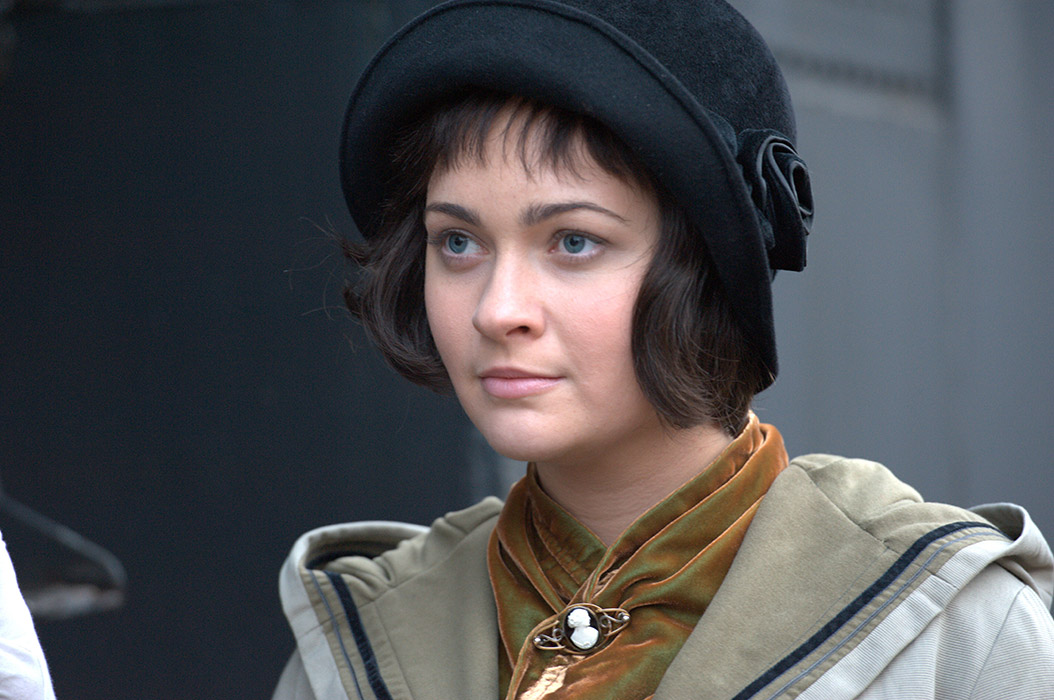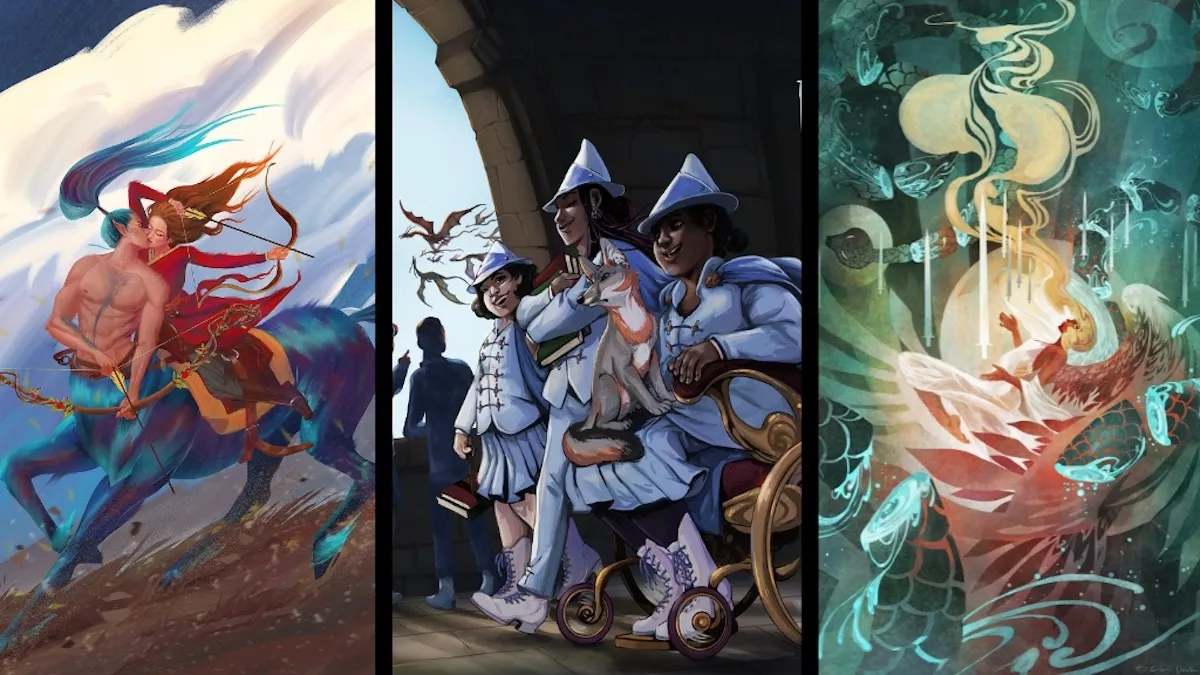
If you are at all familiar with the world of Chagall, you know the image of a woman with dark hair who appears as the subject in many of his works. That woman was Chagall’s first wife Bella Rosenfield, to whom he was married for thirty years, and remembered for another fifty after her death. In the new film Chagall-Malevich, the love story of Bella and Marc is front and center; writer-director Alexander Mitta tells the story as if it were part of Russian folklore, attempting to capture the visual world Chagall created on canvas. Russian actor Leonid Bichevin plays the iconic painter, and newcomer Kristina Schneidermann plays Bella, who would become his muse and author herself.
Schneidermann is Austrian and was a drama student when cast in the film, but it was a serendipitous meeting in Vienna which got her the role. While in Vienna, there was an exhibit of Chagall at the Albertina Museum, and when she was looking at what would become her favorite painting (and the film’s poster image) Over the Town, Schneidermann asked an older man who seemed familiar with Chagall to explain why the two people were flying over the city. This lead to an hour conversation with the man, who would become her director. When he mentioned that he had wanted to make a film about Chagall for 40 years, this peaked Kristina’s interest, and asked if he was a cameraman. When he told her he was, in fact a director, she informed him of her current status as an actress, and she was invited to audition for the role.
Schneidermann was hesitant as she was unsure if he was a professional director; but Mitta is one of Russia’s premiere writer-directors, and after familiarizing herself with his work, she knew he was legitimate. One of the films she mentioned being especially impressed by was 1979’s Air Crew, in which (without CGI of any kind), he staged a massive plane crash and burnt a real plane. Mitta is known for staging such large scale cinematic events, andburned half the town of Vitebsk he had built for Air Town (in the same town it is set). The rest of the town from the film remains up, and has been turned into a museum for Chagall.
Premiering the film there was one of the biggest thrills for Schneidermann (although they screened the film at over twenty international festivals) because Chagall and Bella are considered heroes and icons there. Schneidermann and Leonid were embraced by the crowds at Vitebsk, but the approval Schneidermann most wanted was that of Meret Meyer Graber, Chagall’s granddaughter. She visited Graber twice in the Paris home where Chagall and Bella lived after immigrating.Schneidermann recalled the event of meeting Gaber vividly,
When I came Paris, to the place he lived with Bella, she cooked me dinner and let me help in the kitchen, as if I were like family. And then I sang her a lullaby that I sing in the movie, and she started crying and told me that was a song she used to sing to me. And she said, ‘I feel as if we’ve switched roles and I feel younger.’ As if Bella’s soul is in the apartment and came into me.
Schneidermann felt a close connection to Bella from the very beginning. “I actually found my twin, because I never thought I would find someone so alike physically and morally,” she said. “I know five languages, as did she. We were both only children from families that did all right and were never poor. We looked alike. She wanted to become either an actress or journalist… like me. I fell in love with her, and the only thing I really had to overcome to play the role was understanding the revolution.”
Although the Russian Revolution provides a historical context for the film, Schneidermann feels that’s not the primary appeal of the film, or why Mitta and his collaborators wanted to make the film. “Today we see people do movies which are all about the special effects,” said Schneidermann. “We wanted to really portray the world of Chagall and their love story, which is the most important thing we wanted to capture. Not the look or costumes, or even the Revolution. But in the end of it all, the way love conquers. They fell in love at twenty-one, and until 1998, when he died, he remembered Bella.”
But to capture the world of Chagall does require considerable work, mixing historical accuracy and cinematic bits of magical realism. Their cinematographer hand-painted scenes on the film to give a look which resembled Chagall’s art, and their costume designer used authentic fabrics and designs to give the film the proper period detail. Every member of the cast (including the extras) were given authentic silk stockings to wear. And in the town built for the food was an almost authentic market, including real meat and animals on the streets. Many of the extras in the film were played by the town’s people, eager to take part.
Despite the two hours it took to put on the costumes,Schneidermann admits that she felt very comfortable in the period. As for the gender differences, playing a woman as strong a Bella was a surprise:
She’s portrayed as a really strong character. She’s never afraid and much stronger than Chagall, who is this very dreamy character. And you wouldn’t expect that from a woman who looks so fragile. But she will stand up for her family, and is willing to do anything for their happiness. It kind of surprised me that such a woman existed back then. Now we are emancipated and can stand up for ourselves, but back then, women were kind of under their husband’s control. And we portray a woman who is always upfront and standing up for her husband. Although if he were to say “I want to run away,” she would pack everything. There is a scene in the movie where he is supposed to run away, and she packs their bags. He tells her, they are not going anywhere and she just drops the bags and says “you’re crazy, but I love you, and we’re staying.” She is kind of like a revolutionary lady who would stand up and protect her husband, but there were really women like that back then.
Bella was, in fact, a talent herself; she wrote two books before a relatively young death in 1944. But she put her own ambitions aside in order to support her husband.Schneidermann feels this makes her an essential part of Chagall’s story, because “in a way, she’s even more important than him because she was his base and on her, everything else grew. She gave herself to Chagall, and because of her, he could become famous. That is very rare. To believe in someone that much and trust so much. But she trusted more than anyone else, and believed that he would become the famous artist he did.”
There is also the fact that she appears in so many of his paintings, and that despite being a shy and timid man in real-life (who only did one self-portrait) was unafraid to refer to her as the love of his life.Schneidermann was originally cast with another actor considered for the role of Chagall, who (although more famous the Leonid), didn’t capture the artist’s essence. When she met with Leonid, she was struck, and gave her approval to the director because “I fell in love with the actor’s smile, and that was what we looking for in the actor who would play Chagall. And the director asked me ‘do you feel Chagall?’ and I said ‘yes.'”
Schneidermann is receiving offers for films, but she is being selective because of the experience she had on this film. Although they filmed for two months straight (with just one day off forSchneidermann), she feels the experience was so special because of the dedication of the team behind the scenes, especially the director. “After such a genius director, I can’t just say yes to any director. I have to choose carefully. I’m not sure I want to play with a less experienced director, because with this director, I know I progressed as an actress. I learned something new and I love learning.” That’s good, becauseSchneidermann had to request permission to take time away from drama school to take on the demanding role.
That hasn’t stopped her from working, however. After singing in the film (including the song at the end of the film), she began writing music and ultimately recorded an album under the name of Kristii. And she is performing music live and would even be open to doing musicals… although New York would be where she would like to take that step.
For now, however, she is promoting the film in the US, after the extended international tour of the film internationally. As for the film’s appeal, she believes Chagall’s views of the world is the primary draw.Schneidermann feels “the film takes you into a special world that you dive into and don’t want to come out of. It’s a movie you want to watch multiple times. Our movie stands out because it is so positive, perhaps too positive for some, because it is like a fairytale. Perhaps only 1% will every find the kind of eternal love we portray. I may never find it, but I can say, at least I played it.”
As for the all-important question of sequels,Schneidermann declared “if we could do a sequel, I would gladly play Bella again.”
Lesley Coffin is a New York transplant from the midwest. She is the New York-based writer/podcast editor for Filmoria and film contributor at The Interrobang. When not doing that, she’s writing books on classic Hollywood, including Lew Ayres: Hollywood’s Conscientious Objector and her new book Hitchcock’s Stars: Alfred Hitchcock and the Hollywood Studio System.
—Please make note of The Mary Sue’s general comment policy.—
Do you follow The Mary Sue on Twitter, Facebook, Tumblr, Pinterest, & Google +?









Published: Jun 21, 2015 12:29 pm